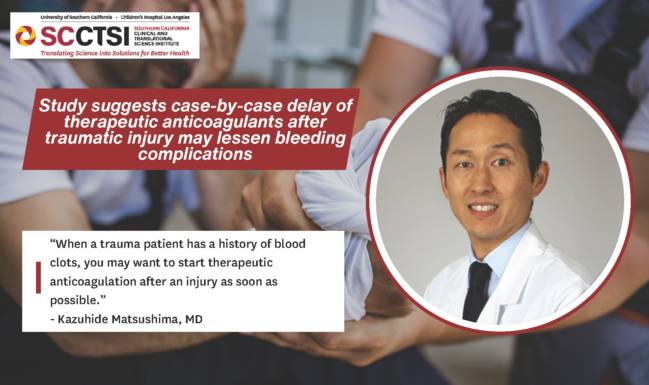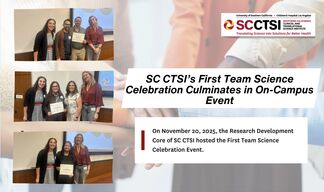Study suggests case-by-case delay of therapeutic anticoagulants after traumatic injury may lessen bleeding complications
SC CTSI biostatistician helps research partners analyze complex hospital data of post-injury patient outcomes.
Clinicians’ top priority when treating traumatic injuries is almost always to control bleeding. But complications can arise. For some patients, blood clots can form at the site of an injury. What’s more, a growing number of trauma patients in emergency departments have pre-existing medical conditions treated with anticoagulation therapy (ACT), which thins the blood and can increase bleeding.
“When a trauma patient has a history of blood clots, you may want to start therapeutic anticoagulation after an injury as soon as possible,” said Kazuhide Matsushima, MD, associate professor of clinical surgery with the Keck School of Medicine of USC. “But you have a dilemma because if you start those blood-thinning medications right away, the patient can develop complex complications.”
Clinicians balance the risk of increased bleeding complications versus the risk of venous thromboembolism or other conditions when determining whether and when to initiate or resume anticoagulant therapy after a traumatic injury. Guidelines for clinicians are lacking, and practice patterns vary widely.

Matsushima led a multi-center study, published in the Journal of Traumatic Acute Care Surgery, analyzing the incidence of hemorrhagic complications in patients who received ACT at some point during hospitalization.
The team included Jeremy Yu, a biostatistician with the Southern California Clinical and Translational Science Institute (SC CTSI), who has provided statistical guidance and analysis to investigators in USC Surgery, and helped this team kick off their work.
“We worked together to carefully develop an appropriate model. The model was based on the Surgery team members’ prior knowledge about variables that potentially needed to be controlled for and the form of the possible relationship with complication,” Yu said. “The model allowed for a spline, a type of curve, and had the potential to be complex, but it turned out the model provided the best estimates when it had a simpler curve.”
In this retrospective study, Matsushima’s team reviewed all trauma admissions at two Level I trauma centers between January 2015 and December 2020 in Los Angeles.
The study included 812 admitted patients with pre-existing use of ACT or pre-injury potential indicators for ACT treatment. Of that number, 442 patients received postinjury ACT. The team separated the total patient population into two groups: those who had bleeding complications and those who did not. A subgroup patients started on ACT within 14 days of injury. The overall incidence of hemorrhagic complications was 12.7%.
“That percentage is not very high, but it’s not something we can ignore,” Matsushima said.
The researchers found that delaying ACT after a traumatic injury might reduce the risk of hemorrhagic complications. Waiting 7 days to 14 days to initiate ACT reduced the odds of complications by 46% and 71%, respectively.
A clinician’s decision to start or resume ACT must be made on a case-by-case basis, assessing the indication, location and severity of injuries, comorbid conditions and other factors.
“Each patient is different,” Matsushima said. “The clinician needs to share decision-making with the patient or family, taking into consideration the risk or benefit of each option.”
This study involved analyzing complex nursing data, requiring a higher-level biostatistics expertise.
“We felt that the support from SC CTSI would be very helpful,” Matsushima said. “Biomedical statistics is advancing very rapidly, and I wanted more options in approaching our research question.”
Some researchers seek to collaborate with an SC CTSI biostatistician only near the end of their projects.
“They run into some issues doing it that way because often they have to start a study over again,” he said.
Bringing biostatistician Jeremy Yu onboard early helped the team publish high-quality results.
“With Jeremy’s expertise, our results were more robust, well supported, and the study was well designed,” Matsushima said. “Jeremy gave us valuable comments and advice on how to proceed with analysis. The outcome has been satisfying in terms of the impact of the publication. And, as always when I work with CTSI people, I learn something new.”



